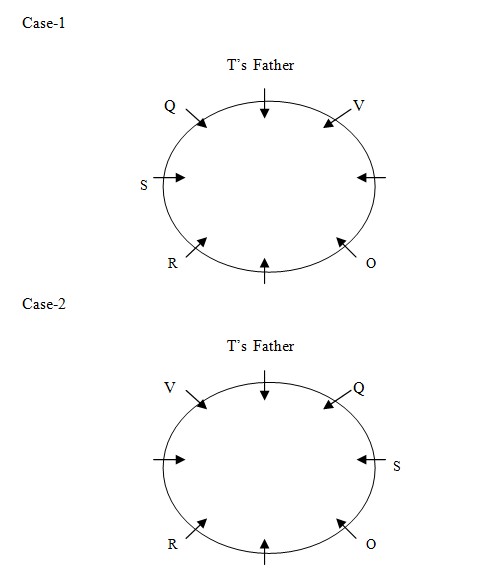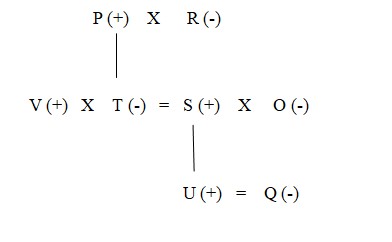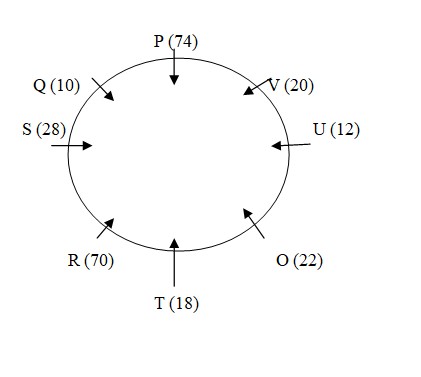Question
How is O related to
V? Study the following information carefully and answer the question below- There is a family of eight people O, P, Q, R, S, T, U and V and are sitting around a circular table facing to the centre. There are three married couples in the family. They are from three generations. None of the member of the third generation is married. They are of different age but their ages are in descending order according to their generation such as Grandfather is the eldest, grandmother is the second eldest, son is the third eldest, daughter- in – law is the fourth eldest, son – in – law is the fifth eldest, daughter is the sixth eldest, grandson is the seventh eldest and granddaughter is the eighth eldest. The person who sits immediate right of V is a male but he is not U. S who is sitting next to Q is not sitting opposite to O. Only the father of T is sitting between Q and V. Q is the female member of the family. V’s age is 2 year less than O’s age and O’s age is 6 year less than S’s age. U’s age is multiple of 4 but not a perfect square. R is the mother of S and her age is 2.5 of the age of her son. R is 4 year younger than P. The age of the second eldest person is 70 year. V is the brother – in – law of O. P does not sit opposite to the second youngest person. T does not belong to third generation. T has no child. The person who is sitting on the immediate left of O and immediate right of R is 18 years old while Q is 10 year old.Solution
The age of the second eldest person is 70 year which means the age of the grandmother is 70 year. V is the brother – in- law of O. V’s age is 2 year less than O’s age and O’s age is 6 year less than S’s age. R is the mother of S and her age is 2.5 of the age of her son. From these it is clear that O, V and S belongs to second generation and R is the grandmother whose age is 70 year. Further, only the father of T is sitting between Q and V. T does not belong to third generation. So, T belongs to second generation. The person who is sitting on the immediate left of O and immediate right of R is 18 year old while Q is 10 year old. S, who is sitting next to Q, is not sitting opposite to O.  Q is the female member of the family. Q is 10 year old. So, Q is the granddaughter and 10 year old. R is 4 year younger than P. Means P is 74 year old. Rest U’s age is multiple of 4 but not a perfect square. As only remaining position is that U is the grandson and is 12 year old. The person who sits immediate right of V is a male but he is not U. So, from this case 3 will be eliminated. As we know that U can’t sit between R and O, so clearly T sit between R and O and U can’t sit to immediate right of Q so from this case 2 will be eliminated. Rest we know that the age of T is 18 year so she is the daughter of P and S is the son of R and is 28 year old. Rest V is 20 year old, O is 22 year old, O is 22 year old. So, the final arrangement is –
Q is the female member of the family. Q is 10 year old. So, Q is the granddaughter and 10 year old. R is 4 year younger than P. Means P is 74 year old. Rest U’s age is multiple of 4 but not a perfect square. As only remaining position is that U is the grandson and is 12 year old. The person who sits immediate right of V is a male but he is not U. So, from this case 3 will be eliminated. As we know that U can’t sit between R and O, so clearly T sit between R and O and U can’t sit to immediate right of Q so from this case 2 will be eliminated. Rest we know that the age of T is 18 year so she is the daughter of P and S is the son of R and is 28 year old. Rest V is 20 year old, O is 22 year old, O is 22 year old. So, the final arrangement is – 

A number is increased by 45% and then decreased by 30%. What is the overall percentage change (increase or decrease) in the number?
A person spent 12.5% of his monthly income on food and 32% of the remaining on rent. If amount spent on rent is Rs 1512, then find the amount spe...
Rajesh spent 40% and 20% of his monthly salary on food and rent, respectively. Of the remaining amount, he gave 15% and 30% to his mother and brother, r...
A bowl contains a colony of bacteria. Every hour, the bacteria population doubles, but immediately after doubling, a virus kills 40% of the population. ...
Each of the articles was marked 55% above its cost price and while selling ‘y’ % discount was given on it. The selling price of the article M is Rs....
- In a class of 5000 students in 2022, 60% were from science stream and rest from commerce. In 2023, science students increased by 33.33% and commerce studen...
The income of ‘A’ increases by 10% every year. If his income 2 years hence from now will be Rs. 27951, then find his income a year before from now.<...
In an exam, Rina scored 54% marks and failed by 80 marks whereas Tina scored 74% marks in the same exam and scored 60 marks more than the passing marks....
The cost price of juice is 50% more than the cost price of lemon soda. A juice seller mixed 120 ml of juice with 30 ml of lemon soda in a glass. By mist...
In a company interview test, 65% of the students passed in the first round, and 55% passed in the technical round, while 15% of students failed in both ...


